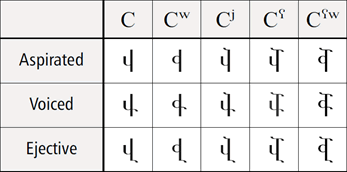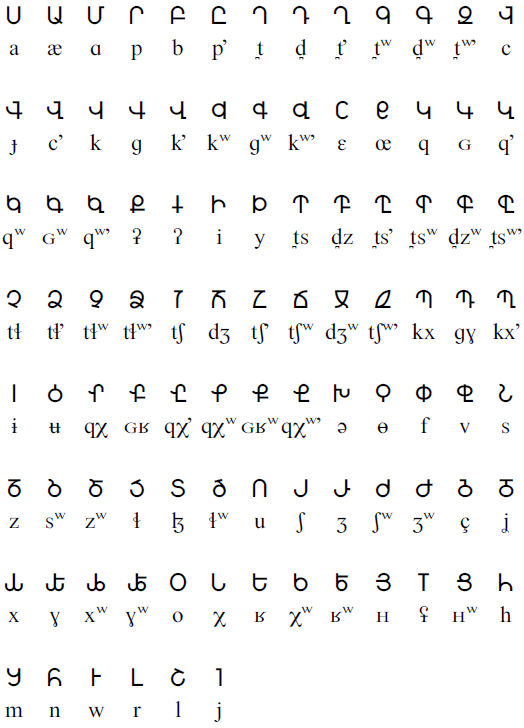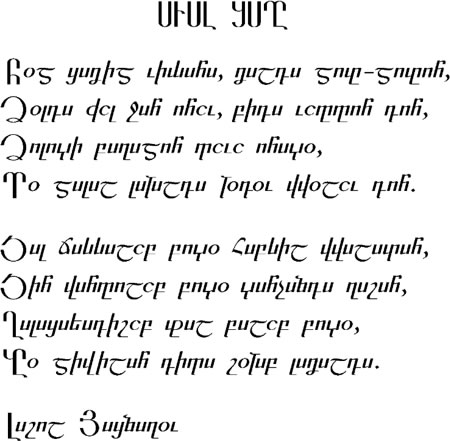The Pan-Caucasian alphabet is a unified writing system proposed by Vazgen R. Ghazaryan, intended for autochthonous and threatened languages of Northwest Caucasian and Northeast Caucasian language families. Most of these languages are unwritten, and many that are unique by their grammatical and phonetic properties, are either extinct or on the verge of extinction, being reduced to a few hundred or thousand speakers, such as Abaza, Archi, Akhvakh, Khinalug, Khwarshi, Tsez, Hinukh, Hunzib, Bezhta, Ghodoberi, Kryts, Budukh, Udi, and others.
The threats these languages face are stipulated not only by historical and political realities of the North Caucasus, but also by the absence of one of the most essential components, which shape the identity of ethnic communities – a centuries-old written tradition and heritage. Standardized alphabets for some North Caucasian languages have been implemented only in the 20th century based on Latin and Cyrillic scripts. Nonetheless, both express radically different phonetic structures, and therefore are extremely deficient for the intended purposes. Despite somewhat positive role in literary development of some of these languages, they continue to pose serious difficulties not only for graphical harmony and aesthetics of composition, but for practical application and functionality as well, since being limited in the number of characters and insufficient in flexibility of graphical modifications, remain fundamentally incapable of unambiguous rendition of outstandingly rich phonetics of the North Caucasian languages (50-60 phonemes in average, some reaching 120) and often violate the alphabetic principle, i.e. systematic and predictable correspondence between written graphemes and spoken phonemes.
The Cyrillic script lacks any graphical correspondence for uvular, pharyngeal, epiglottal, and glottal stops, affricates, fricatives, and sonorants, which in Caucasian languages abound. Moreover, in the majority of current alphabets, unaesthetic and constrained di-, tri-, tetra- and pentagraphs (ххьIв, кIкIв, чIчIв, ххьI, ллъв, гъIв, кхъу, ккв, ххв, къь, гъу, хъу, кIу, жъу, etc.) often exceed 50% of the total inventory. During adaptation, an essentially substandard approach was shown in choosing the characters and their combinations, failing to represent the orthographies of even closely related languages in the same way. All this, combined with complex sociolinguistic situation, hinders their competitiveness under the dominance of the official one with an identical writing system.
To overcome the mentioned difficulties, the author proposes new and phonetically complete featural alphabets that match the complex intrinsic features of North Caucasian languages, render these with full phonemic representativeness and alphabetical unambiguity, and are free from any irrelevant political or cultural context and enforcing influence. They are based on peculiar usage of the morphological principles of construction of bimillennial South Caucasian alphabets (Armenian, Old Georgian, and Caucasian Albanian), which are distinguished by highest grapheme-to-phoneme correspondence. The set of distinct rules for grapheme formation, similar to the principles used in abugidas, makes the large number of visual forms easily memorable, permanently resolving the issue of united orthography in a coherent Pan-Caucasian context.
Additionally, an independent alphabet is presented for the Ossetic language, which is an integral part of the Caucasian heritage.
The Pan-Caucasian alphabet is shaped by two fundamental principles:
To achieve maximum efficiency of character usage, two generic alphabets are introduced for NWC and NEC language families, wherefrom the specific alphabet for each language is deduced. The common phonemes are encoded similarly, while distinctions are made only in graphical assignments of mutually missing sets. The alphabets can be either unicameral or bicameral (the set of cursive letters is not presented). The generic vowel system and marking of phonation and coarticulations is the same for both inventories.
The protoforms of NWC and NEC systems are the following.

Evidently, the memorization of these alphabets is not difficult, as they contain only 32/34 basic letters (26/28 consonants and 6 vowels), less than in Cyrillic script.
The rest of the characters are regularly shaped from these protoforms via 5 simple rules, which is more economic than the unpredictable, unduly tangled and confusing combinations one must keep in mind while dealing with current adaptations.
1. Rules of expression of airstream mechanisms ("three-level" phonation):
2. Rules of expression of coarticulation:
All these rules can be combined in the same protoform to create multi-extensional letters. They never cause articulatory ambiguity as the chosen graphical rules of modification eliminate any possibility of similar resultant portrayal of different phonemes.
An example of the application of these rules for consonants is presented in the figure below.

As seen, all 15 resultant letters are distinct and encode all necessary peculiarities of articulation found in the North Caucasian languages. The labialization can be combined with pharyngealization (creating a labiopharyngealized consonant); the marking of phonation does not interfere with the graphical expression of articulations.
Thus, by this approach, a special morphological function is given to supplementary extensions, which carry no particular meaning in the South Caucasian alphabets and have appeared in mere consequence of genealogical and calligraphic peculiarities of historical evolution. In this way, the introduced alphabets become featural, since the shapes of the letters are not arbitrary, but inherently encode various articulatory features of the phonemes they represent.
For vowels, the set of phonation rules do not apply (therefore the usage of the middle and bottom extensions is arbitrary), while coarticulation rules apply.
The full generalized alphabets for the NWC and NEC language families are presented below in IPA transcriptions.

Note: The NEC alphabet is slightly different in appearance. Here it is presented with no indication of diverse language-specific coarticulations. The most noticeable differences occur in affricates and laterals, as well as in more elaborated vowel systems, since the NEC languages generally have a well-developed vocalism with such articulatory features as nasalization, pharyngealization, tonal pitch etc., which in every particular case are expressed by means of graphical extensions that have phonetic assignments different from those used for consonant modifications.
As an illustrative text, the poem "Avar language" by Rasul Hamzatov is shown below in new Avar alphabet.

For in-depth details, see:
https://www.academia.edu/35623857/A_Proposal_for_Pan_Caucasian_Alphabet
V.R. Ghazaryan, "A Proposal for Pan-Caucasian Alphabet" (monograph, in Armenian and Russian, with English synopsis), Yerevan, 2012, 336 p., ISBN 978-9939-0-0603-1
V.R. Ghazaryan, "A Proposal for Pan-Caucasian Alphabet", Handes Amsorya. Zeitschrift für Armenische Philologie, Wien, 2013, 1-12, pp. 237-280
Constructed scripts for: Ainu | Arabic | Chinese languages | Dutch | English | Hawaiian | Hungarian | Japanese | Korean | Lingala | Malay & Indonesian | Persian | Tagalog / Filipino | Russian | Sanskrit | Spanish | Taino | Turkish | Vietnamese | Welsh | Other natural languages | Colour-based scripts | Tactile scripts | Phonetic/universal scripts | Constructed scripts for constructed languages | Adaptations of existing alphabets | Fictional alphabets | Magical alphabets | A-Z index | How to submit a constructed script
[top]
You can support this site by Buying Me A Coffee, and if you like what you see on this page, you can use the buttons below to share it with people you know.

If you like this site and find it useful, you can support it by making a donation via PayPal or Patreon, or by contributing in other ways. Omniglot is how I make my living.
Note: all links on this site to Amazon.com, Amazon.co.uk
and Amazon.fr
are affiliate links. This means I earn a commission if you click on any of them and buy something. So by clicking on these links you can help to support this site.
[top]